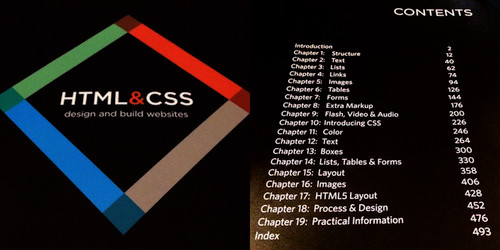How Does One "Code"?
As you write HTML and CSS code for the assigned modules in this class, you will constantly incorporate new features that make your webpages more professional, useful, entertaining, and aesthetically pleasing. All of these modules are working to give you the individual skills you will need to develop and eventually combine to complete your final project website. As stated on the Introduction page, Google.com and other helpful websites are likely to be your most valuable and turned to resources. However, another would be Jon Duckett's textbook, HTML&CSS: Design and Build Websites.

Some of the most useful chapters to be found within this book include:

Chapter 1: Structure
Here you learn about the basics of HTML & tags, elements, and attributes. This will form the foundation of your HTML and CSS knowledge.
Chapter 2: Text
Here you learn about headings & horizontal rules, paragraphs & line breaks, text formats (e.g.; italics), and quotations, abbreviations, & citations. This teaches you the very basics of HTML coding one needs to have before bring in more complicated HTML elements or CSS code.
Chapter 3: Lists
Here you learn about lists obviously, but there a several types:
- ordered lists in which list items are numbered,
- unordered lists (like this one) in which each item is set off by a bullet point,
- definition lists in which each list item is followed by a definition,
- and nested lists in which one list is subordinate to another, larger list.
Chapter 4: Links
As you have probably noticed, there are plenty of embedded links in the content of this page. Here is where you learn how to make them. Again though, there are several kinds (those between your site's pages, those to other websites, and those to email addresses). Some links can orient the user's screen to a specified area of the webpage.
Chapter 5: Images
Here you learn about images in HTML. You'll learn how to properly add images to webpages, customize their appearance, and include important attributes in your tags.
Chapter 10: Introducing CSS
Here you learn what CSS is, how its rules work, and the different selectors that will hold your style declarations.
Chapter 11: Color
Here you learn how to manipulate the colors of your text, backgrounds, borders, etc. You will be taught to effectively choose colors using RGB(A), Hex Codes, Color Names, and HSL(A).
Chapter 12: Text
In this chapter, you will learn about all the ways you can modify the appearance of your website's text with CSS. By the end you will be able to customize typeface, size, style (i.e., bold, italic, underlined), word-spacing, letter-spacing, line-height, text alignment, text indentation, and even how to customize your hyperlinks.
Chapter 13: Boxes
Here you learn how to use the div element to stylize the layout of your webpages. Each HTML object acts as its own entity that is surrounded by a "box". With CSS you can not only make the box visible but you can adjust its dimensions, borders, margins, outlines, and padding.
Chapter 15: Layout
In this chapter you will learn to use CSS code to affect the visual layout of your webpages rather than just letting the browsers display things according to their order within your HTML code (static positioning). It is key to pay attention to relative, absolute, and fixed positioning too. The floating of elements will be crucial for creating a multi-column webpage.
Chapter 16: Images
Finally, in this chapter you learn about the ways in which CSS code can help you to make the most of your images. You can specify image dimensions, make it float (like an element), align them horizontally and/or vertically, set an image as your background, and even implement image sprites.
